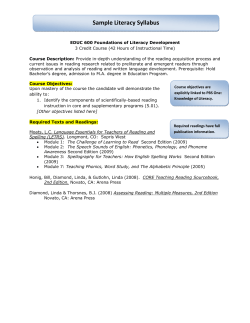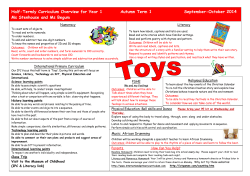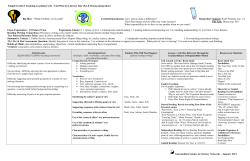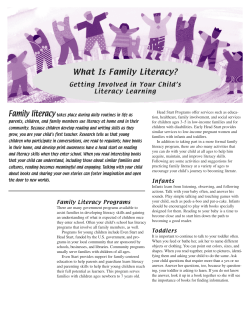
Three Explicit Teaching Strategies. Victoria Cochrane M.Ed.
Three Explicit Teaching Strategies. Victoria Cochrane M.Ed. ? All Classroom Teachers Are Interventionists, Aren’t They? ( Yes, when they have time!) The importance of reflecting on one’s own teaching and learning program cannot be overlooked. What is missing from my program that seems to not be meeting the needs of these children? The difference between success and failure in student outcomes is dependent on a highly effective classroom teacher (Louden et. Al., 2005; Hattie, 2003;National Reading Panel, 2000; Snow et. Al., 1998;). All other support and intervention programs are supplementary and must be delivered in conjunction and collaboration with the classroom teacher (Clay, 1991; 2001; 2005; Westwood, 1997). Support programs are merely icing on the cake. Without the cake, icing cannot do it’s work effectively , which is to complement the overall presentation of the cake. The teacher, who can be represented as the cake, is the main and most important part of the whole. In the same way, support programs cannot ever be truly effective unless they are delivered in support of the classroom program, not in isolation from it. My Classroom Literacy programme was based upon the research of Hill and Crevola (1997) and the Flying Start document (2002). Students matched to text. Students grouped in same ability groupings. Same routine followed every day. Ideally, two hours set aside for literacy. Whole-group, small-group, teaching wholegroup model followed. Students work independently on follow-up or consolidation tasks. Use of visual timetables, visual task-boards, class expectations and behaviour charts. The building up of the class as a supportive, learning community all assist in children being able to work with minimum supervision (Gibbs, 2001) Modelled, shared and guided reading; modelled, shared, interactive and guided writing (First Steps, 2003; Fountas and Pinnell, 2000; Exploring Effective Teaching Strategies, 2002) One of four models of classroom literacy practice, in Hart and Bridge 2002,Flying start; exploring effective literacy teaching and learning. A Tasmanian perspective. My literacy program was not providing enough scaffolding and support for five children in my Grade One/Two class in: Spelling; Phonological and Phonemic Awareness; Recognition of sight words; Decoding strategies; Becoming independent and confident learners. This was evident due to their high dependency on support and general lack of progress in these areas. The Strengths: Provision of individual support for students. Assessment of alphabetic and spelling knowledge. Monitoring of progress. Use of a spelling journal. Inclusion of chunking sounds. The Gaps The predominant use of sight words (MIOUW 100 words, Reiter, 2004) as their spelling words (They were not ready for whole-word processing). Significant consonant and/or vowel confusions not addressed explicitly. Difficulty with phonemic awareness (ability to hear sounds in words) not addressed explicitly. Writing words in whole sentences a requirement beyond skill and confidence level. The requirement of students to chunk words and then use the L.S.C.W.C method to learn them. The chunking activity was too difficult for target students to manage independently. Alphabetical Order/using the dictionary independently; some of the students had not yet consolidated alphabetic knowledge sufficiently. Guided Reading delivered twice a week. Reading skills explicitly taught. Regular running records and monitoring of progress in reading. Graphic organisers and other thinking strategies used to aid deeper comprehension of texts. The Gaps in target students knowledge: Lack of consolidation of alphabetic (basic phonological) knowledge. Poor letter/sound analysis. Limited knowledge of concepts about print. Very poor sight words recognition. Lack of fluency. Limited strategies for problem solving text. Inability to take words apart (chunk). The Strengths. Quarter book writing, interactive writing and handwriting being taught explicitly. Modelled and guided writing used to scaffold and support students. Differentiated writing activities and expectations. The Gaps Often not enough time for writing. Letter confusions not addressed in handwriting properly. Students very dependent on teacher support. Grade One/Two Reading Levels August 40 1 35 2 3 30 4 25 5 6 20 7 15 8 9 10 10 5 11 12 0 1 2 3 4 5 6 7 8 9 10 11 12 13 14 15 16 17 18 19 20 21 22 23 24 25 26 Grade One/Two Reading Levels December 40 1 35 2 3 30 4 25 5 6 20 7 15 8 9 10 10 5 11 12 0 1 2 3 4 5 6 7 8 9 10 11 12 13 14 15 16 17 18 19 20 21 22 23 24 25 26 Matt increased his sight word knowledge by 34 words. He went up 3 reading levels. James increased his sight word knowledge by 27 words. He went up 6 reading levels. Increased his sight words knowledge by 21 words without ML. He improved by 4 reading levels (Began the research on level 0). Daniel increased his sight word knowledge by 29 words. He went up 5 reading levels. Sam increased his sight word knowledge by 24 words. He went up 6 reading levels. Problem: Poor ability to hear sounds in words (phonemic awareness). Remediation Strategy: Elkonin Sound Boxes (Clay, 2001) Research shows that ability to hear sounds in words is the strongest indicator of spelling success. A child will not be able to see and represent sounds in words until they can hear them (Clay, 2001). That is why children very rarely represent vowels in their early writing attempts. •bogglesworldesl.com/elkonin_boxes.htm Elkonin Elkonin Boxes is a Reading Recovery (Clay, 2001) technique that encourages children to listen for sounds in words away from letters. Educator’s will be more effective in teaching young children to read and write when they allow them to begin with sounds and associate them to letters rather than matching letters to sounds (Clay, 1991, 2001). Teaching children to tune into sounds early may avoid the need for remediation later on. Problem: Very poor sight word recognition. Remediation Strategy: Mastery Learning (Bloom, 1994) of Magic 100 (Reiter, 2004) words. One of the main reasons for students not progressing in reading was an inability to recognise common words appearing in the first five reading levels (e.g. here, said, come, look). Mastery learning proposes that all children can learn when provided with the appropriate learning conditions in the classroom http://oaks.nvg.org, 2009). The application of mastery learning is based on Benjamin Bloom’s Learning for Mastery model (1956, in Bloom, 1994). Using his methods, the average student of Bloom’s Mastery class passed at the 95th percentile of traditionally taught classes (http://oaks.nvg.org, 2009). Mastery learning does not focus on content, but on the process of mastering it. The empowerment comes with being able to see the progress being made (Westwood, 1997). Celebrating successes are an important part of the learning process. Problem: Lack of confidence to write independently. Poor ability to hear and represent sounds. Remediation Strategy: Quarter Book Writing. Encompasses Language Experience (First Steps, 2003) and Cut-Up Sentence (Clay, 2001). It can also include interactive writing (Clay, 2001; Fountas and Pinnel, 2000). Is teacher guided. Links reading and writing. Is relevant to the child. Encourages independence. Teaches reading and writing strategies. Develops phonemic and phonological awareness. Develops self-checking and accountability. Shows progress over time for assessment purposes. Can incorporate interactive writing. Quarter book keeps you very busy. Only do it in small groups of 4 to 6 children !! Support students to: Consolidate basic phonological knowledge. Improve letter/sound analysis. Take words apart and say the sounds separately for easier decoding. Sort out letter confusions interfering with progress. Improve handwriting and letter formation. Structure a simple sentence. Spelling and Mastery Learning strategies were completed before school began. Parents, aides and supportive students helped to supervise and administer mastery learning and spelling. Quiet reading times were used to listen to targeted students read and/or to administer sound boxes. Parent support was important. Involved parents were trained to tutor their child at home in sound boxes and reading strategies (Senechal and Young, 2009). Needs were also targeted through other literacy activities and small group work. Not all strategies were used with all students. The mark of highly effective teachers include: Direct, explicit teaching (Edwards-Groves, 2003. Differentiated literacy programme to meet diverse learning needs (Westwood, 1997). Direct guidance of learning through classroom interactions (Hattie, 2003). Extra scaffolding for targeted students. Provision of guided practice and re-teaching where required (Westwood, 1997; Wallace and Kauffman, 1973). Monitoring, assessment and feedback. (Tasmanian English curriculum, 2007; Hattie, 2003;Westwood, 1997); A classroom environment where students and teacher build respect, warmth and rapport (McDonald Connor et.al., 2009; Lewis et. al., 2007; Louden et. al., 2005). Teaching children how to learn and to become engaged in the learning (Westwood, 1997). An ability to be a reflective and flexible practitioner (Edwards-Groves, 2003). The classroom teacher is ultimately responsible for student outcomes (Snow et. Al., 1998; National Reading Panel, 2004). No amount of added intervention can replace an excellent classroom literacy programme (Hattie, 2003; Snow et. al., 1998; Hill and Crevola, 1997; Westwood, 1997; Clay, 1991,2001). All teachers are interventionists; it is the timerestraints of the classroom that are often the restricting and prohibitive factor that often prevent all children receiving the individual attention from the teacher that they need and deserve (Edwards-Groves,2002; Westwood, 1997). Anderson, L.W. and Sosniak, L. A (Eds.). (1994). Bloom’s taxonomy: A forty year perspective. In The ninety-third yearbook of the national society for the study of education Part 2. Illinois, Chicago: University of Chicago Press. Berk, L. E. and Winsler, A. (1995). Scaffolding children’s learning: Vygotsky and early childhood education. Washington: National Association for the Education of Young Children (NAEYC). Blachman, B A. Ph.D., Wynne-Ball, E. Ph.D.; Roche La Black, M.S.; & Tangel,D (2000). Road to the code: A phonological awareness program for young children. N. Y: Paul H Brookes Publishing Co. Bloom, Benjamin S. (1994). Reflections on the development and use of the taxonomy. In Anderson, L.W., and Sosniak, L.A. (1994. Bloom’s Taxonomy: A forty year restrospective (pp. 1-9 ) Chicago, Illinois: University of Chicago Press. Clay, Marie M. (2001). Reading recovery: A guidebook for teachers in training. N.Z.: Heinemann Education. First Published 1993. Clay, Marie M. (2001). Observation survey. N.Z.: Heinemann Education. First Published1993. Clay, Marie M. (1991). Becoming literate: The construction of inner control. N.Z.: Heinemann Education. Clay, Marie M. (2005). Literacy lessons designed for individuals, Part One. Why? When? and How? N.Z.: Heinemann Press. Edwards-Groves, C. (2002). Connecting students to learning through explicit teaching. In Vervoorn, J. & van Haren, R., (2002). My Read: Strategies for teaching reading in the middle years. Retrieved April, 2009 from http://www.myread.org/explicit.htm. Edwards-Groves, C. (2002) Building an inclusive classroom through explicit pedagogy: A focus on the language of teaching. In Anstey, M. and Bull, G. (2003) The Literacy lexicon. Second Edition (pp 83-102). Australia: Pearson Education. Fountas, I. C., and Pinnell, G.S. (2000). Guiding readers and writers. Australia: Heinemann. Hart, M. & Bridge, D. (2002). Flying start; exploring effective literacy teaching and learning. A Tasmanian perspective. Department of Education. Tasmania: Printing Authority. Hattie, J. (2003). Teachers make a difference: What is the research evidence? Distinguishing expert teachers from novice and experienced teachers. Australian Council for Educational Research. October Hill, P. and Crevola, C. (1998). Key features of a whole-school, design approach to literacy teaching in schools. Australia: University of Melbourne Press. Louden, W., Rohl, M., Barrett-Pugh, C., Brown, C., Cairney, T., Elderfield, J., House, H., Meires, M., Rivalland, J., & Rowe, K. (2005). In teachers’ hands; Effective literacy teaching practices in the early years of schooling. Department of Education, Science and Training, Australia: Edith Cowen University. Munro, J. (1998). Phonological and phonemic awareness: Their impact on learning to read prose and to spell. Australian Journal of Learning Disabilities. Vol 3, No.2, pp.15-21. Kinnes, T. (2009). Benjamin Bloom and the taxonomy of learning-The gold scales. In Learning theorists .Retrieved March 2009 from: http://oaks.nvg.org/taxonomy-bloom.html . Randall,B., Giles, J. and Nellie, E. (2000) PM benchmark kit: An assessment resource for emergent-12 years. Australia: Rigby, Houghton, Mifflin Harcourt Publishers. Reiter, Marcella, (2004) MIOOW Magic 100 words learning centres resource Australia: Magic Words International. Rupely, W. H., Blair, T. R. and Nicholls, W. D., (2009). Effective reading instruction for struggling readers: the role of direct/explicit teaching. Reading and Writing Quarterly. Volume 25 Number 2, April; pp. 125–138 Senechal, M. and Young, L. (2008). The effect of literacy interventions on children’s acquisition of reading From kindergarten to Grade 3: A meta-analytic review. Review of Educational Research. December, Vol. 78, No. 4, pp. 880-907. Smith, L., Dockrell, J. and Tomlinson, P. (Editors). (1997). Piaget, Vygotsky and beyond: Future issues for developmental psychology and education. London: Routlege. Snow, C.E., Burns, M.S., Griffin, P. (1998). Preventing reading difficulties in young children. National Research Council. N.Y: National Academy Press. Waddington, C.H., (2000). Waddington diagnostic reading test. Australia: Waddington Educational Resources. Wallace, G. and Kauffman, J. M., (1973, 1978) Teaching children With learning problems. Columbus, Ohio: Charles E. Merrill Publishing Company West Australian Minister of Education and Training. (WAMET). (2003). First Steps: Addressing current literacy challenges. Reading map of development.; Reading resource book.; Writing map of development.; Writing resource book.; Linking assessment, teaching and learning. Second Edition (First Printed in 1993) Australia: Pearson Education Westwood, P. (1997) .Commonsense methods for children with special needs. Third Edition. London and New York: Routledge. Westwood, P. (2005) .South Australian spelling test. Australia: Australian Council for Educational Research (ACER). Victoria Cochrane Literacy Advisor Association of Independent Schools Tasmania victoria.cochrane@education.tas.gov.au
© Copyright 2025










